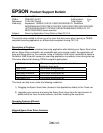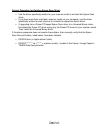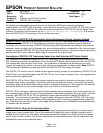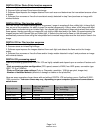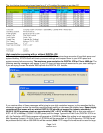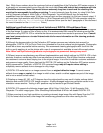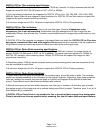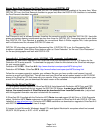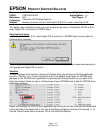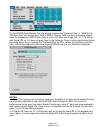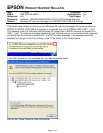
Page 5 of 6
PSB.2004.09.001
DIGITAL ICE for Film scanning specifications
1) DIGITAL ICE for Film supports resolutions of 50 to 12800 dpi; however it is highly recommended that the
image not exceed 30,000 X 30,000 pixels or 6.25” x 6.25” at 4800dpi.
2) Only the following resolutions are supported by DIGITAL ICE for Film: 150, 300, 600, 1200, 2400, 3600,
4800 dpi. Epson Scan will scan images at these resolutions for DIGITAL ICE and then reduce or expand the
image into the user’s required scanning resolution.
3) A minimum image size of 128 x 128 pixels is required for DIGITAL ICE for Film processing.
DIGITAL ICE for Film limitations
1) DIGITAL ICE for Film supports correction for all color film types. However,
Kodachrome color
transparency film is not recommended
. Kodachrome film dyes attenuate the IR light in ways that are
substantially different than all other film. Therefore, some Kodachrome film images may exhibit under or over
correction.
2) DIGITAL ICE for Film supports chromogenic (dye-based) black and white film.
DIGITAL ICE for Film does
not support conventional black and white negative film
because the silver retained in the film scatters the
IR light which causes an inaccurate record of defects found during the scanning process.
DIGITAL ICE for Photo Prints scanning specifications
1) DIGITAL ICE for Photo Prints supports resolutions of 50 to 12800 dpi; however, the image should not
exceed 30,000 X 30,000 pixels or 6.25” x 6.25” at 4800dpi. The actual maximum resolution is 1200dpi for
DIGITAL ICE; therefore, when scanning above 1200dpi, EPSON Scan will expand the image into user
required scan resolution.
2) Resolutions above 1200 dpi require computer memory and processing power and time requirements that
may be unsuitable for most users.
3) A minimum image size of 440 x 440 pixels is required for DIGITAL ICE for Photo processing.
DIGITAL ICE for Photo Prints limitations
1) Large defects such as tears and creases will be corrected up to around 64 pixels in width. The correction
quality may depend somewhat on the orientation of the original. However, fingerprints, tape, platen scratches
(seen as a straight line scratch that runs the length of a photo) and fingerprints are difficult to detect and
correct. These defects cannot be effectively detected and removed.
2) Manual touch-ups such as hand-written drawings, text from pen or markers, ink and other type of marks
that appear as part of the image and not as surface defects are difficult to detect. Therefore, most, if not all, of
these defects will go undetected.
3) DIGITAL ICE for Photo Prints is not intended for fine or household dust removal from photographs.
Photo(s) should be as clean as possible before scanning. See item #2 under Additional specifications.



